Critical Analysis: Minimum Wage Impact on Australian Economy
VerifiedAdded on 2022/11/14
|9
|2546
|458
Essay
AI Summary
This essay provides a comprehensive analysis of the advantages of lower minimum wage increases in Australia. It utilizes various economic theories to assess the impact on the labor market, employees, businesses, and the overall economy. The essay examines the effects of wage increases on labor demand and supply, employee income and living standards, and the financial implications for Australian companies. It explores the potential consequences of higher minimum wages, including impacts on employment, human capital development, and international competitiveness. The analysis considers short-term and long-term effects, drawing on surveys and research to support its arguments. The essay concludes with a discussion of the potential for economic growth, the impact on small businesses, and the importance of balanced wage policies. This essay offers a critical perspective on the complexities of minimum wage policies and their implications for Australia's economic future.
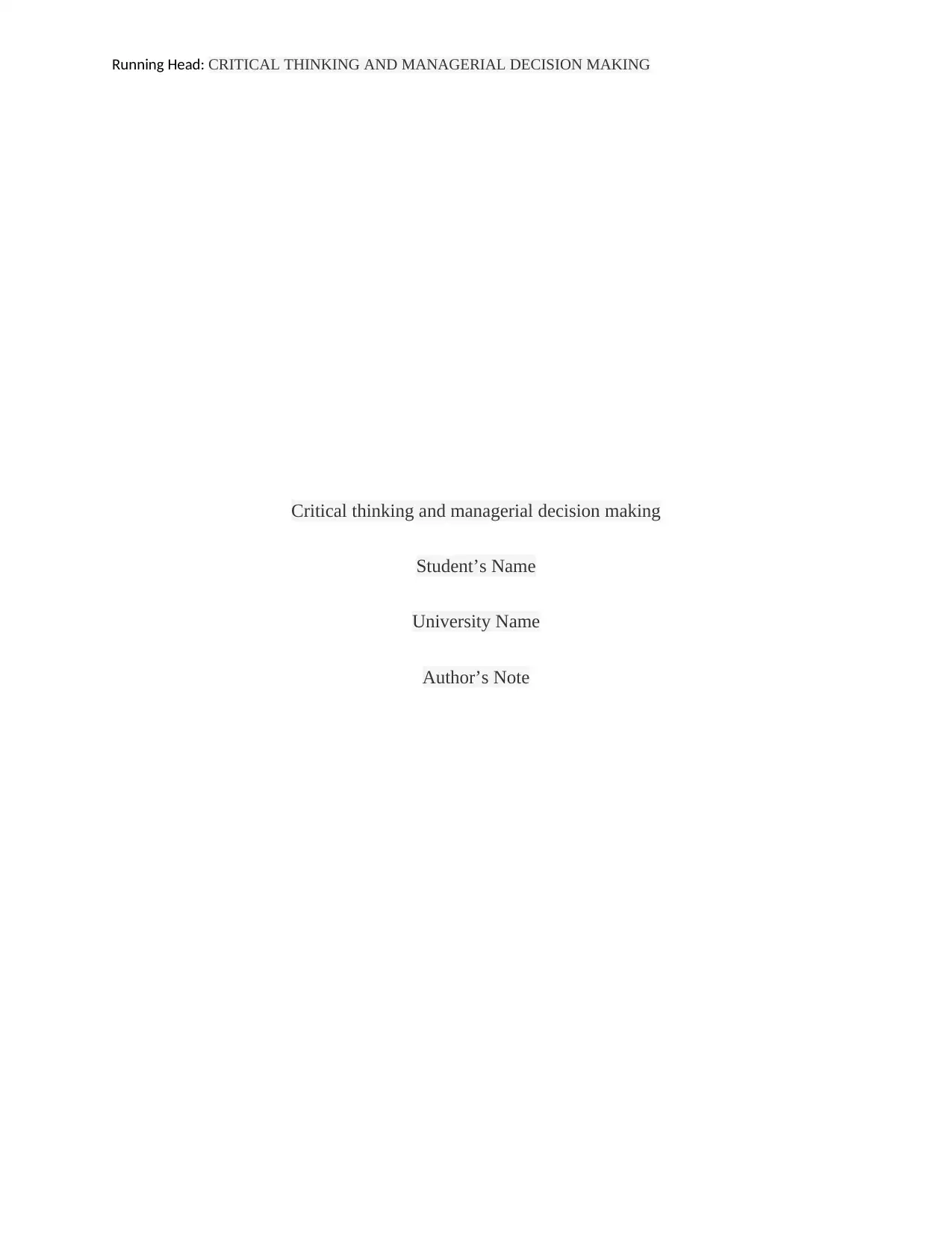
Running Head: CRITICAL THINKING AND MANAGERIAL DECISION MAKING
Critical thinking and managerial decision making
Student’s Name
University Name
Author’s Note
Critical thinking and managerial decision making
Student’s Name
University Name
Author’s Note
Paraphrase This Document
Need a fresh take? Get an instant paraphrase of this document with our AI Paraphraser
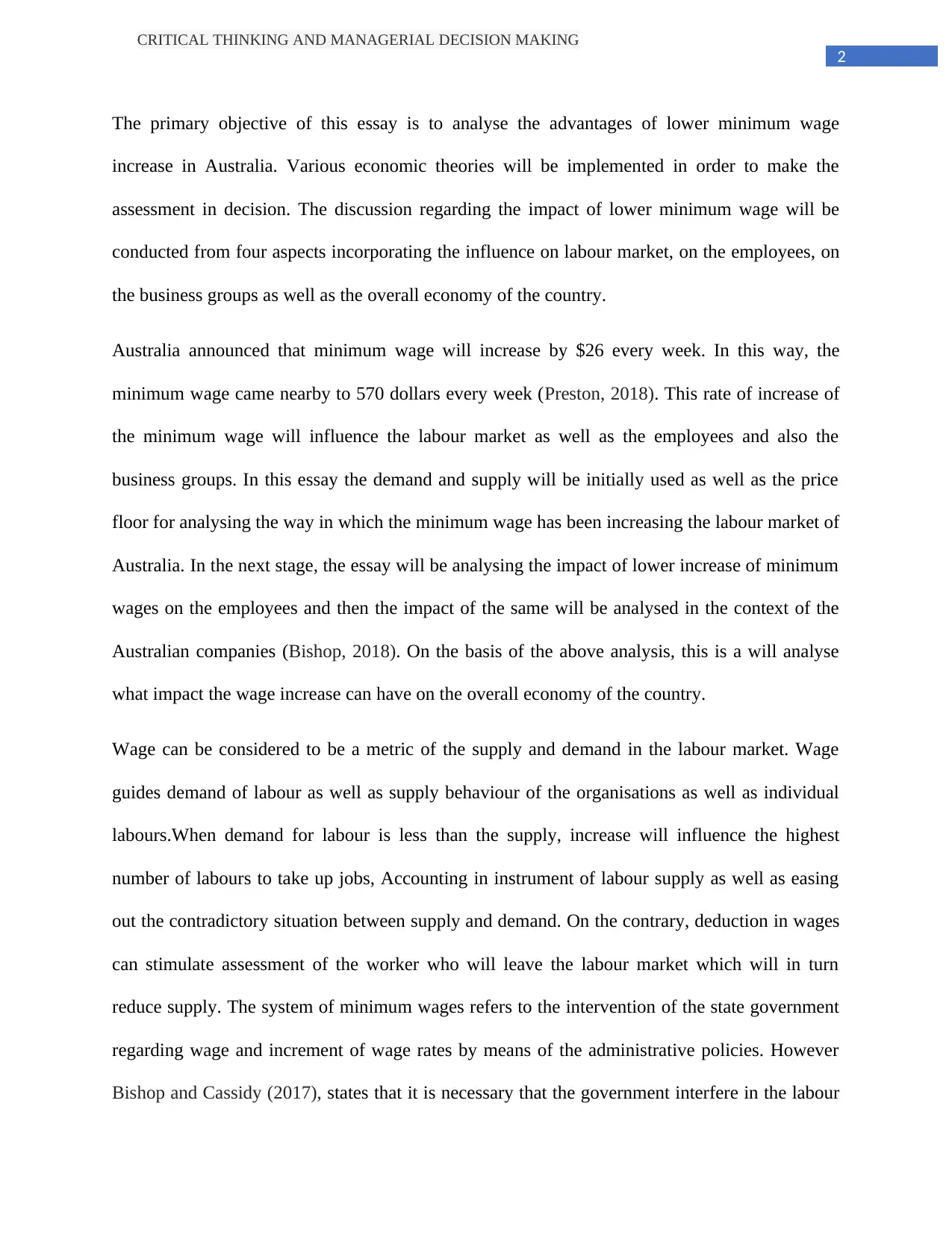
2
CRITICAL THINKING AND MANAGERIAL DECISION MAKING
The primary objective of this essay is to analyse the advantages of lower minimum wage
increase in Australia. Various economic theories will be implemented in order to make the
assessment in decision. The discussion regarding the impact of lower minimum wage will be
conducted from four aspects incorporating the influence on labour market, on the employees, on
the business groups as well as the overall economy of the country.
Australia announced that minimum wage will increase by $26 every week. In this way, the
minimum wage came nearby to 570 dollars every week (Preston, 2018). This rate of increase of
the minimum wage will influence the labour market as well as the employees and also the
business groups. In this essay the demand and supply will be initially used as well as the price
floor for analysing the way in which the minimum wage has been increasing the labour market of
Australia. In the next stage, the essay will be analysing the impact of lower increase of minimum
wages on the employees and then the impact of the same will be analysed in the context of the
Australian companies (Bishop, 2018). On the basis of the above analysis, this is a will analyse
what impact the wage increase can have on the overall economy of the country.
Wage can be considered to be a metric of the supply and demand in the labour market. Wage
guides demand of labour as well as supply behaviour of the organisations as well as individual
labours.When demand for labour is less than the supply, increase will influence the highest
number of labours to take up jobs, Accounting in instrument of labour supply as well as easing
out the contradictory situation between supply and demand. On the contrary, deduction in wages
can stimulate assessment of the worker who will leave the labour market which will in turn
reduce supply. The system of minimum wages refers to the intervention of the state government
regarding wage and increment of wage rates by means of the administrative policies. However
Bishop and Cassidy (2017), states that it is necessary that the government interfere in the labour
CRITICAL THINKING AND MANAGERIAL DECISION MAKING
The primary objective of this essay is to analyse the advantages of lower minimum wage
increase in Australia. Various economic theories will be implemented in order to make the
assessment in decision. The discussion regarding the impact of lower minimum wage will be
conducted from four aspects incorporating the influence on labour market, on the employees, on
the business groups as well as the overall economy of the country.
Australia announced that minimum wage will increase by $26 every week. In this way, the
minimum wage came nearby to 570 dollars every week (Preston, 2018). This rate of increase of
the minimum wage will influence the labour market as well as the employees and also the
business groups. In this essay the demand and supply will be initially used as well as the price
floor for analysing the way in which the minimum wage has been increasing the labour market of
Australia. In the next stage, the essay will be analysing the impact of lower increase of minimum
wages on the employees and then the impact of the same will be analysed in the context of the
Australian companies (Bishop, 2018). On the basis of the above analysis, this is a will analyse
what impact the wage increase can have on the overall economy of the country.
Wage can be considered to be a metric of the supply and demand in the labour market. Wage
guides demand of labour as well as supply behaviour of the organisations as well as individual
labours.When demand for labour is less than the supply, increase will influence the highest
number of labours to take up jobs, Accounting in instrument of labour supply as well as easing
out the contradictory situation between supply and demand. On the contrary, deduction in wages
can stimulate assessment of the worker who will leave the labour market which will in turn
reduce supply. The system of minimum wages refers to the intervention of the state government
regarding wage and increment of wage rates by means of the administrative policies. However
Bishop and Cassidy (2017), states that it is necessary that the government interfere in the labour
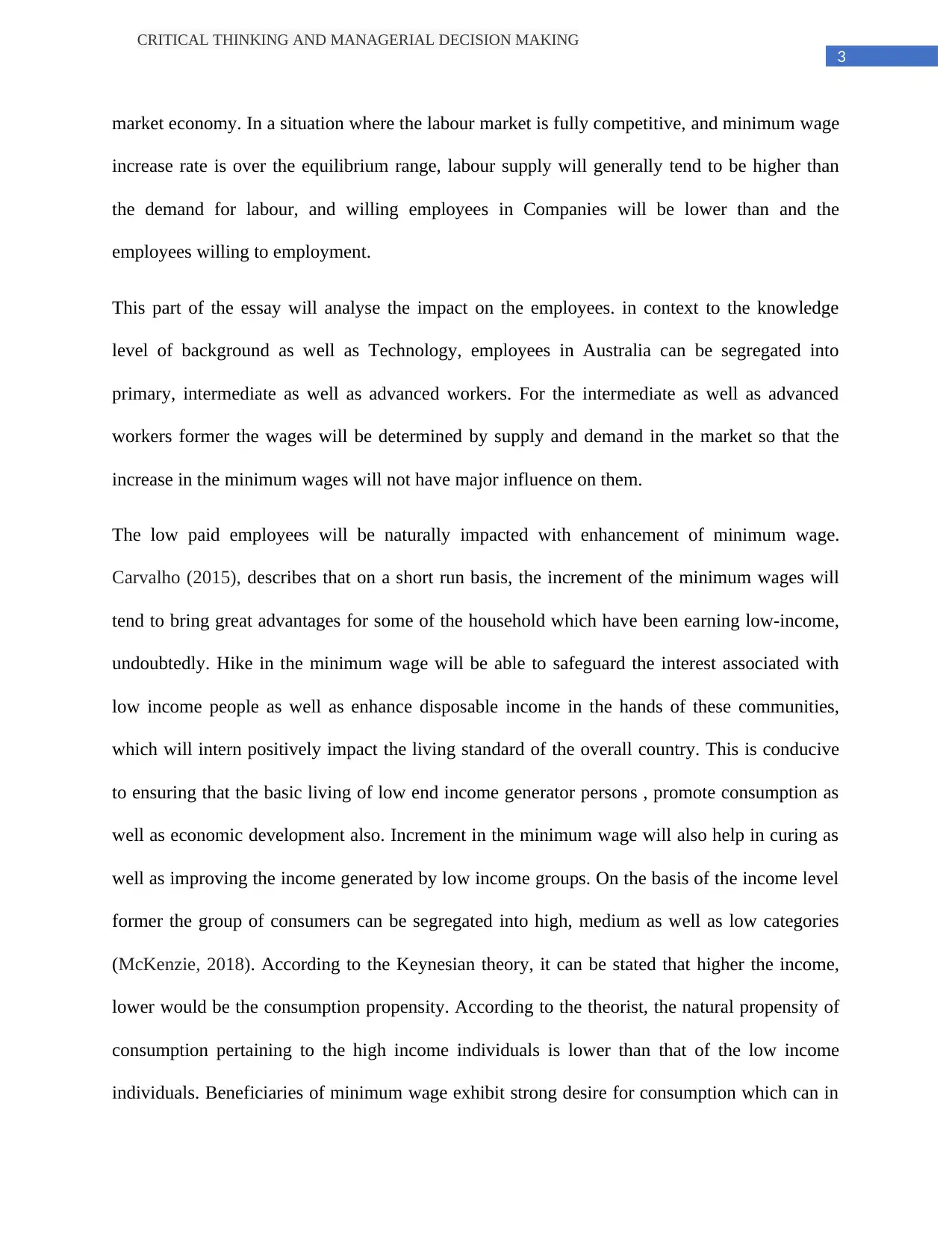
3
CRITICAL THINKING AND MANAGERIAL DECISION MAKING
market economy. In a situation where the labour market is fully competitive, and minimum wage
increase rate is over the equilibrium range, labour supply will generally tend to be higher than
the demand for labour, and willing employees in Companies will be lower than and the
employees willing to employment.
This part of the essay will analyse the impact on the employees. in context to the knowledge
level of background as well as Technology, employees in Australia can be segregated into
primary, intermediate as well as advanced workers. For the intermediate as well as advanced
workers former the wages will be determined by supply and demand in the market so that the
increase in the minimum wages will not have major influence on them.
The low paid employees will be naturally impacted with enhancement of minimum wage.
Carvalho (2015), describes that on a short run basis, the increment of the minimum wages will
tend to bring great advantages for some of the household which have been earning low-income,
undoubtedly. Hike in the minimum wage will be able to safeguard the interest associated with
low income people as well as enhance disposable income in the hands of these communities,
which will intern positively impact the living standard of the overall country. This is conducive
to ensuring that the basic living of low end income generator persons , promote consumption as
well as economic development also. Increment in the minimum wage will also help in curing as
well as improving the income generated by low income groups. On the basis of the income level
former the group of consumers can be segregated into high, medium as well as low categories
(McKenzie, 2018). According to the Keynesian theory, it can be stated that higher the income,
lower would be the consumption propensity. According to the theorist, the natural propensity of
consumption pertaining to the high income individuals is lower than that of the low income
individuals. Beneficiaries of minimum wage exhibit strong desire for consumption which can in
CRITICAL THINKING AND MANAGERIAL DECISION MAKING
market economy. In a situation where the labour market is fully competitive, and minimum wage
increase rate is over the equilibrium range, labour supply will generally tend to be higher than
the demand for labour, and willing employees in Companies will be lower than and the
employees willing to employment.
This part of the essay will analyse the impact on the employees. in context to the knowledge
level of background as well as Technology, employees in Australia can be segregated into
primary, intermediate as well as advanced workers. For the intermediate as well as advanced
workers former the wages will be determined by supply and demand in the market so that the
increase in the minimum wages will not have major influence on them.
The low paid employees will be naturally impacted with enhancement of minimum wage.
Carvalho (2015), describes that on a short run basis, the increment of the minimum wages will
tend to bring great advantages for some of the household which have been earning low-income,
undoubtedly. Hike in the minimum wage will be able to safeguard the interest associated with
low income people as well as enhance disposable income in the hands of these communities,
which will intern positively impact the living standard of the overall country. This is conducive
to ensuring that the basic living of low end income generator persons , promote consumption as
well as economic development also. Increment in the minimum wage will also help in curing as
well as improving the income generated by low income groups. On the basis of the income level
former the group of consumers can be segregated into high, medium as well as low categories
(McKenzie, 2018). According to the Keynesian theory, it can be stated that higher the income,
lower would be the consumption propensity. According to the theorist, the natural propensity of
consumption pertaining to the high income individuals is lower than that of the low income
individuals. Beneficiaries of minimum wage exhibit strong desire for consumption which can in
⊘ This is a preview!⊘
Do you want full access?
Subscribe today to unlock all pages.

Trusted by 1+ million students worldwide
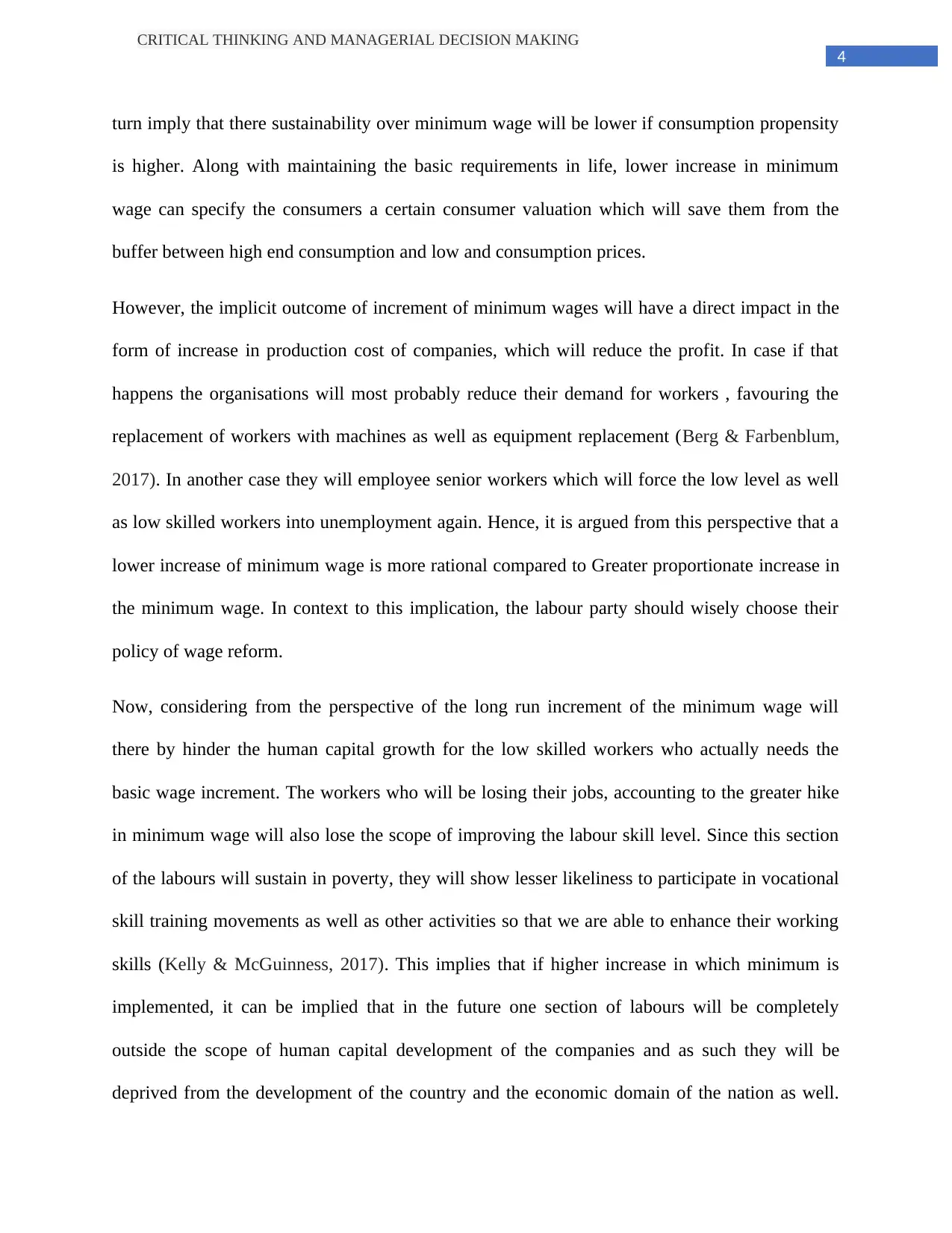
4
CRITICAL THINKING AND MANAGERIAL DECISION MAKING
turn imply that there sustainability over minimum wage will be lower if consumption propensity
is higher. Along with maintaining the basic requirements in life, lower increase in minimum
wage can specify the consumers a certain consumer valuation which will save them from the
buffer between high end consumption and low and consumption prices.
However, the implicit outcome of increment of minimum wages will have a direct impact in the
form of increase in production cost of companies, which will reduce the profit. In case if that
happens the organisations will most probably reduce their demand for workers , favouring the
replacement of workers with machines as well as equipment replacement (Berg & Farbenblum,
2017). In another case they will employee senior workers which will force the low level as well
as low skilled workers into unemployment again. Hence, it is argued from this perspective that a
lower increase of minimum wage is more rational compared to Greater proportionate increase in
the minimum wage. In context to this implication, the labour party should wisely choose their
policy of wage reform.
Now, considering from the perspective of the long run increment of the minimum wage will
there by hinder the human capital growth for the low skilled workers who actually needs the
basic wage increment. The workers who will be losing their jobs, accounting to the greater hike
in minimum wage will also lose the scope of improving the labour skill level. Since this section
of the labours will sustain in poverty, they will show lesser likeliness to participate in vocational
skill training movements as well as other activities so that we are able to enhance their working
skills (Kelly & McGuinness, 2017). This implies that if higher increase in which minimum is
implemented, it can be implied that in the future one section of labours will be completely
outside the scope of human capital development of the companies and as such they will be
deprived from the development of the country and the economic domain of the nation as well.
CRITICAL THINKING AND MANAGERIAL DECISION MAKING
turn imply that there sustainability over minimum wage will be lower if consumption propensity
is higher. Along with maintaining the basic requirements in life, lower increase in minimum
wage can specify the consumers a certain consumer valuation which will save them from the
buffer between high end consumption and low and consumption prices.
However, the implicit outcome of increment of minimum wages will have a direct impact in the
form of increase in production cost of companies, which will reduce the profit. In case if that
happens the organisations will most probably reduce their demand for workers , favouring the
replacement of workers with machines as well as equipment replacement (Berg & Farbenblum,
2017). In another case they will employee senior workers which will force the low level as well
as low skilled workers into unemployment again. Hence, it is argued from this perspective that a
lower increase of minimum wage is more rational compared to Greater proportionate increase in
the minimum wage. In context to this implication, the labour party should wisely choose their
policy of wage reform.
Now, considering from the perspective of the long run increment of the minimum wage will
there by hinder the human capital growth for the low skilled workers who actually needs the
basic wage increment. The workers who will be losing their jobs, accounting to the greater hike
in minimum wage will also lose the scope of improving the labour skill level. Since this section
of the labours will sustain in poverty, they will show lesser likeliness to participate in vocational
skill training movements as well as other activities so that we are able to enhance their working
skills (Kelly & McGuinness, 2017). This implies that if higher increase in which minimum is
implemented, it can be implied that in the future one section of labours will be completely
outside the scope of human capital development of the companies and as such they will be
deprived from the development of the country and the economic domain of the nation as well.
Paraphrase This Document
Need a fresh take? Get an instant paraphrase of this document with our AI Paraphraser
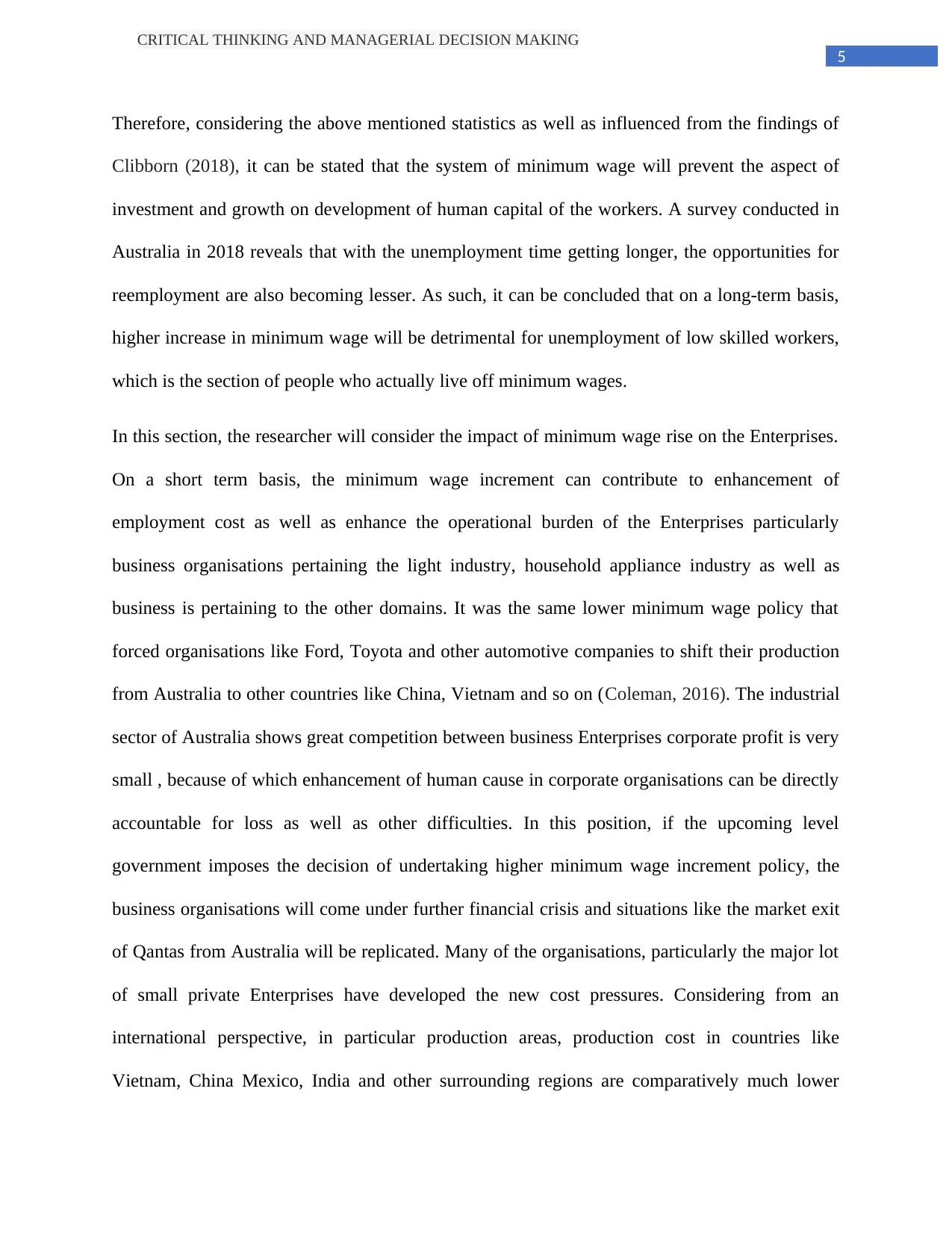
5
CRITICAL THINKING AND MANAGERIAL DECISION MAKING
Therefore, considering the above mentioned statistics as well as influenced from the findings of
Clibborn (2018), it can be stated that the system of minimum wage will prevent the aspect of
investment and growth on development of human capital of the workers. A survey conducted in
Australia in 2018 reveals that with the unemployment time getting longer, the opportunities for
reemployment are also becoming lesser. As such, it can be concluded that on a long-term basis,
higher increase in minimum wage will be detrimental for unemployment of low skilled workers,
which is the section of people who actually live off minimum wages.
In this section, the researcher will consider the impact of minimum wage rise on the Enterprises.
On a short term basis, the minimum wage increment can contribute to enhancement of
employment cost as well as enhance the operational burden of the Enterprises particularly
business organisations pertaining the light industry, household appliance industry as well as
business is pertaining to the other domains. It was the same lower minimum wage policy that
forced organisations like Ford, Toyota and other automotive companies to shift their production
from Australia to other countries like China, Vietnam and so on (Coleman, 2016). The industrial
sector of Australia shows great competition between business Enterprises corporate profit is very
small , because of which enhancement of human cause in corporate organisations can be directly
accountable for loss as well as other difficulties. In this position, if the upcoming level
government imposes the decision of undertaking higher minimum wage increment policy, the
business organisations will come under further financial crisis and situations like the market exit
of Qantas from Australia will be replicated. Many of the organisations, particularly the major lot
of small private Enterprises have developed the new cost pressures. Considering from an
international perspective, in particular production areas, production cost in countries like
Vietnam, China Mexico, India and other surrounding regions are comparatively much lower
CRITICAL THINKING AND MANAGERIAL DECISION MAKING
Therefore, considering the above mentioned statistics as well as influenced from the findings of
Clibborn (2018), it can be stated that the system of minimum wage will prevent the aspect of
investment and growth on development of human capital of the workers. A survey conducted in
Australia in 2018 reveals that with the unemployment time getting longer, the opportunities for
reemployment are also becoming lesser. As such, it can be concluded that on a long-term basis,
higher increase in minimum wage will be detrimental for unemployment of low skilled workers,
which is the section of people who actually live off minimum wages.
In this section, the researcher will consider the impact of minimum wage rise on the Enterprises.
On a short term basis, the minimum wage increment can contribute to enhancement of
employment cost as well as enhance the operational burden of the Enterprises particularly
business organisations pertaining the light industry, household appliance industry as well as
business is pertaining to the other domains. It was the same lower minimum wage policy that
forced organisations like Ford, Toyota and other automotive companies to shift their production
from Australia to other countries like China, Vietnam and so on (Coleman, 2016). The industrial
sector of Australia shows great competition between business Enterprises corporate profit is very
small , because of which enhancement of human cause in corporate organisations can be directly
accountable for loss as well as other difficulties. In this position, if the upcoming level
government imposes the decision of undertaking higher minimum wage increment policy, the
business organisations will come under further financial crisis and situations like the market exit
of Qantas from Australia will be replicated. Many of the organisations, particularly the major lot
of small private Enterprises have developed the new cost pressures. Considering from an
international perspective, in particular production areas, production cost in countries like
Vietnam, China Mexico, India and other surrounding regions are comparatively much lower
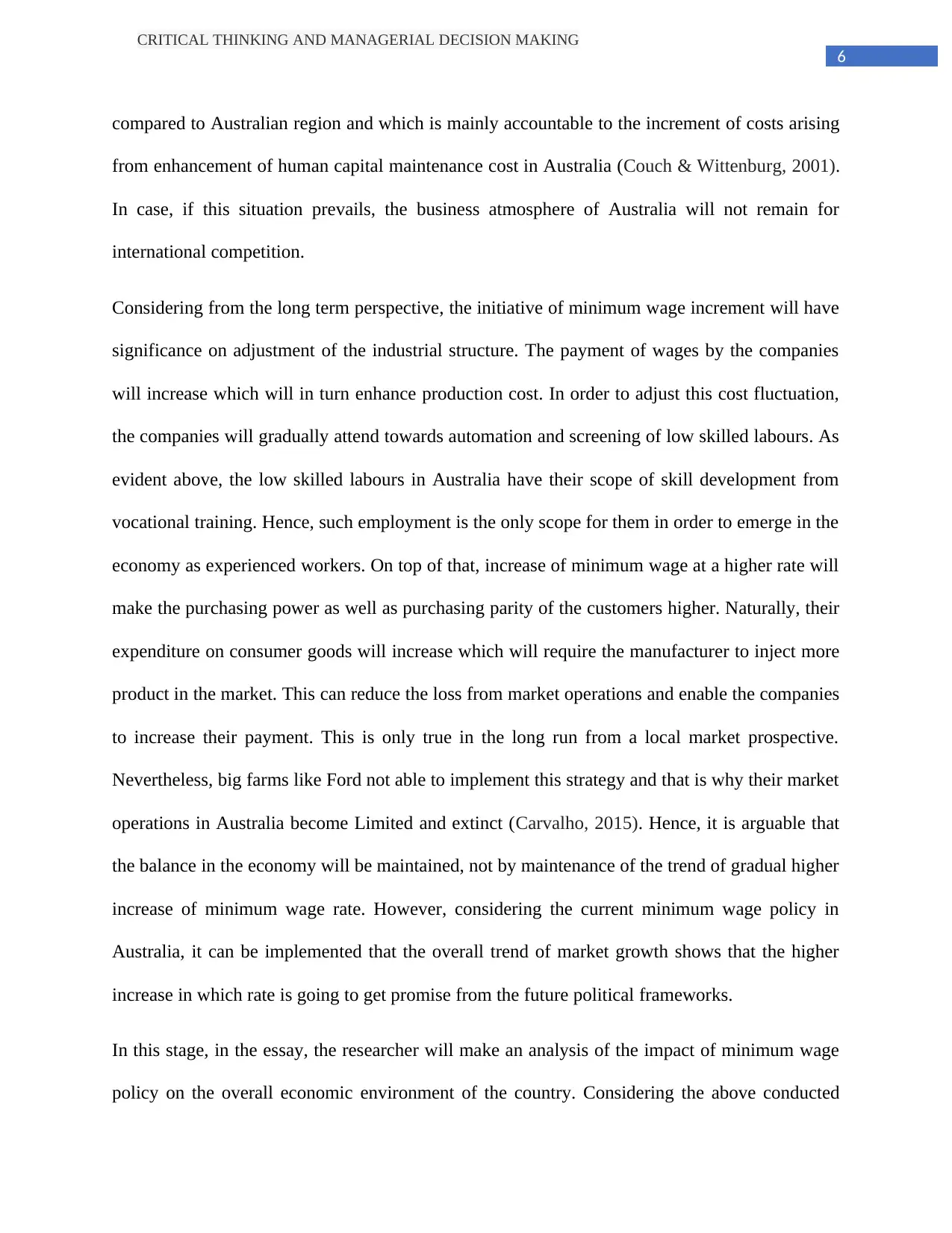
6
CRITICAL THINKING AND MANAGERIAL DECISION MAKING
compared to Australian region and which is mainly accountable to the increment of costs arising
from enhancement of human capital maintenance cost in Australia (Couch & Wittenburg, 2001).
In case, if this situation prevails, the business atmosphere of Australia will not remain for
international competition.
Considering from the long term perspective, the initiative of minimum wage increment will have
significance on adjustment of the industrial structure. The payment of wages by the companies
will increase which will in turn enhance production cost. In order to adjust this cost fluctuation,
the companies will gradually attend towards automation and screening of low skilled labours. As
evident above, the low skilled labours in Australia have their scope of skill development from
vocational training. Hence, such employment is the only scope for them in order to emerge in the
economy as experienced workers. On top of that, increase of minimum wage at a higher rate will
make the purchasing power as well as purchasing parity of the customers higher. Naturally, their
expenditure on consumer goods will increase which will require the manufacturer to inject more
product in the market. This can reduce the loss from market operations and enable the companies
to increase their payment. This is only true in the long run from a local market prospective.
Nevertheless, big farms like Ford not able to implement this strategy and that is why their market
operations in Australia become Limited and extinct (Carvalho, 2015). Hence, it is arguable that
the balance in the economy will be maintained, not by maintenance of the trend of gradual higher
increase of minimum wage rate. However, considering the current minimum wage policy in
Australia, it can be implemented that the overall trend of market growth shows that the higher
increase in which rate is going to get promise from the future political frameworks.
In this stage, in the essay, the researcher will make an analysis of the impact of minimum wage
policy on the overall economic environment of the country. Considering the above conducted
CRITICAL THINKING AND MANAGERIAL DECISION MAKING
compared to Australian region and which is mainly accountable to the increment of costs arising
from enhancement of human capital maintenance cost in Australia (Couch & Wittenburg, 2001).
In case, if this situation prevails, the business atmosphere of Australia will not remain for
international competition.
Considering from the long term perspective, the initiative of minimum wage increment will have
significance on adjustment of the industrial structure. The payment of wages by the companies
will increase which will in turn enhance production cost. In order to adjust this cost fluctuation,
the companies will gradually attend towards automation and screening of low skilled labours. As
evident above, the low skilled labours in Australia have their scope of skill development from
vocational training. Hence, such employment is the only scope for them in order to emerge in the
economy as experienced workers. On top of that, increase of minimum wage at a higher rate will
make the purchasing power as well as purchasing parity of the customers higher. Naturally, their
expenditure on consumer goods will increase which will require the manufacturer to inject more
product in the market. This can reduce the loss from market operations and enable the companies
to increase their payment. This is only true in the long run from a local market prospective.
Nevertheless, big farms like Ford not able to implement this strategy and that is why their market
operations in Australia become Limited and extinct (Carvalho, 2015). Hence, it is arguable that
the balance in the economy will be maintained, not by maintenance of the trend of gradual higher
increase of minimum wage rate. However, considering the current minimum wage policy in
Australia, it can be implemented that the overall trend of market growth shows that the higher
increase in which rate is going to get promise from the future political frameworks.
In this stage, in the essay, the researcher will make an analysis of the impact of minimum wage
policy on the overall economic environment of the country. Considering the above conducted
⊘ This is a preview!⊘
Do you want full access?
Subscribe today to unlock all pages.

Trusted by 1+ million students worldwide
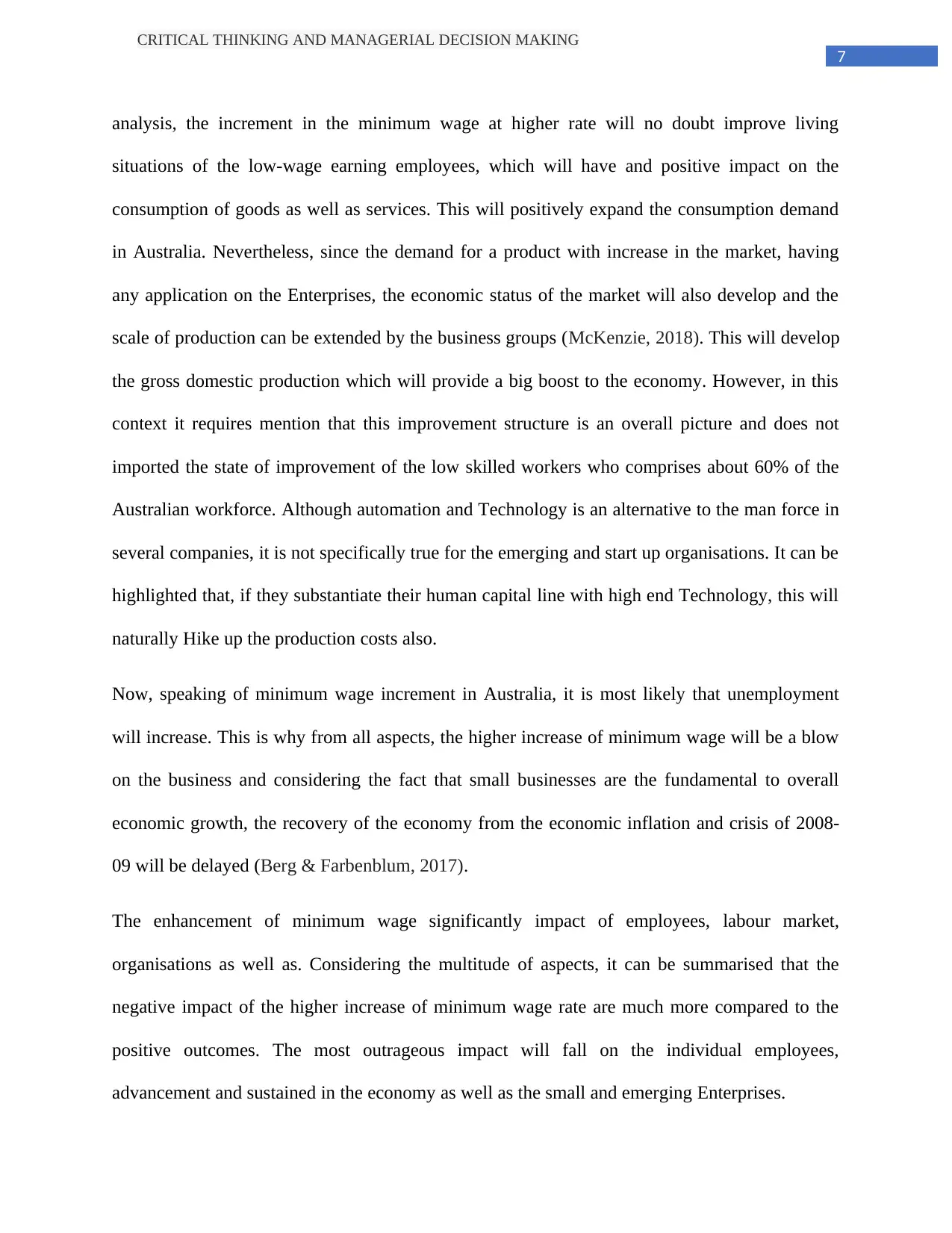
7
CRITICAL THINKING AND MANAGERIAL DECISION MAKING
analysis, the increment in the minimum wage at higher rate will no doubt improve living
situations of the low-wage earning employees, which will have and positive impact on the
consumption of goods as well as services. This will positively expand the consumption demand
in Australia. Nevertheless, since the demand for a product with increase in the market, having
any application on the Enterprises, the economic status of the market will also develop and the
scale of production can be extended by the business groups (McKenzie, 2018). This will develop
the gross domestic production which will provide a big boost to the economy. However, in this
context it requires mention that this improvement structure is an overall picture and does not
imported the state of improvement of the low skilled workers who comprises about 60% of the
Australian workforce. Although automation and Technology is an alternative to the man force in
several companies, it is not specifically true for the emerging and start up organisations. It can be
highlighted that, if they substantiate their human capital line with high end Technology, this will
naturally Hike up the production costs also.
Now, speaking of minimum wage increment in Australia, it is most likely that unemployment
will increase. This is why from all aspects, the higher increase of minimum wage will be a blow
on the business and considering the fact that small businesses are the fundamental to overall
economic growth, the recovery of the economy from the economic inflation and crisis of 2008-
09 will be delayed (Berg & Farbenblum, 2017).
The enhancement of minimum wage significantly impact of employees, labour market,
organisations as well as. Considering the multitude of aspects, it can be summarised that the
negative impact of the higher increase of minimum wage rate are much more compared to the
positive outcomes. The most outrageous impact will fall on the individual employees,
advancement and sustained in the economy as well as the small and emerging Enterprises.
CRITICAL THINKING AND MANAGERIAL DECISION MAKING
analysis, the increment in the minimum wage at higher rate will no doubt improve living
situations of the low-wage earning employees, which will have and positive impact on the
consumption of goods as well as services. This will positively expand the consumption demand
in Australia. Nevertheless, since the demand for a product with increase in the market, having
any application on the Enterprises, the economic status of the market will also develop and the
scale of production can be extended by the business groups (McKenzie, 2018). This will develop
the gross domestic production which will provide a big boost to the economy. However, in this
context it requires mention that this improvement structure is an overall picture and does not
imported the state of improvement of the low skilled workers who comprises about 60% of the
Australian workforce. Although automation and Technology is an alternative to the man force in
several companies, it is not specifically true for the emerging and start up organisations. It can be
highlighted that, if they substantiate their human capital line with high end Technology, this will
naturally Hike up the production costs also.
Now, speaking of minimum wage increment in Australia, it is most likely that unemployment
will increase. This is why from all aspects, the higher increase of minimum wage will be a blow
on the business and considering the fact that small businesses are the fundamental to overall
economic growth, the recovery of the economy from the economic inflation and crisis of 2008-
09 will be delayed (Berg & Farbenblum, 2017).
The enhancement of minimum wage significantly impact of employees, labour market,
organisations as well as. Considering the multitude of aspects, it can be summarised that the
negative impact of the higher increase of minimum wage rate are much more compared to the
positive outcomes. The most outrageous impact will fall on the individual employees,
advancement and sustained in the economy as well as the small and emerging Enterprises.
Paraphrase This Document
Need a fresh take? Get an instant paraphrase of this document with our AI Paraphraser
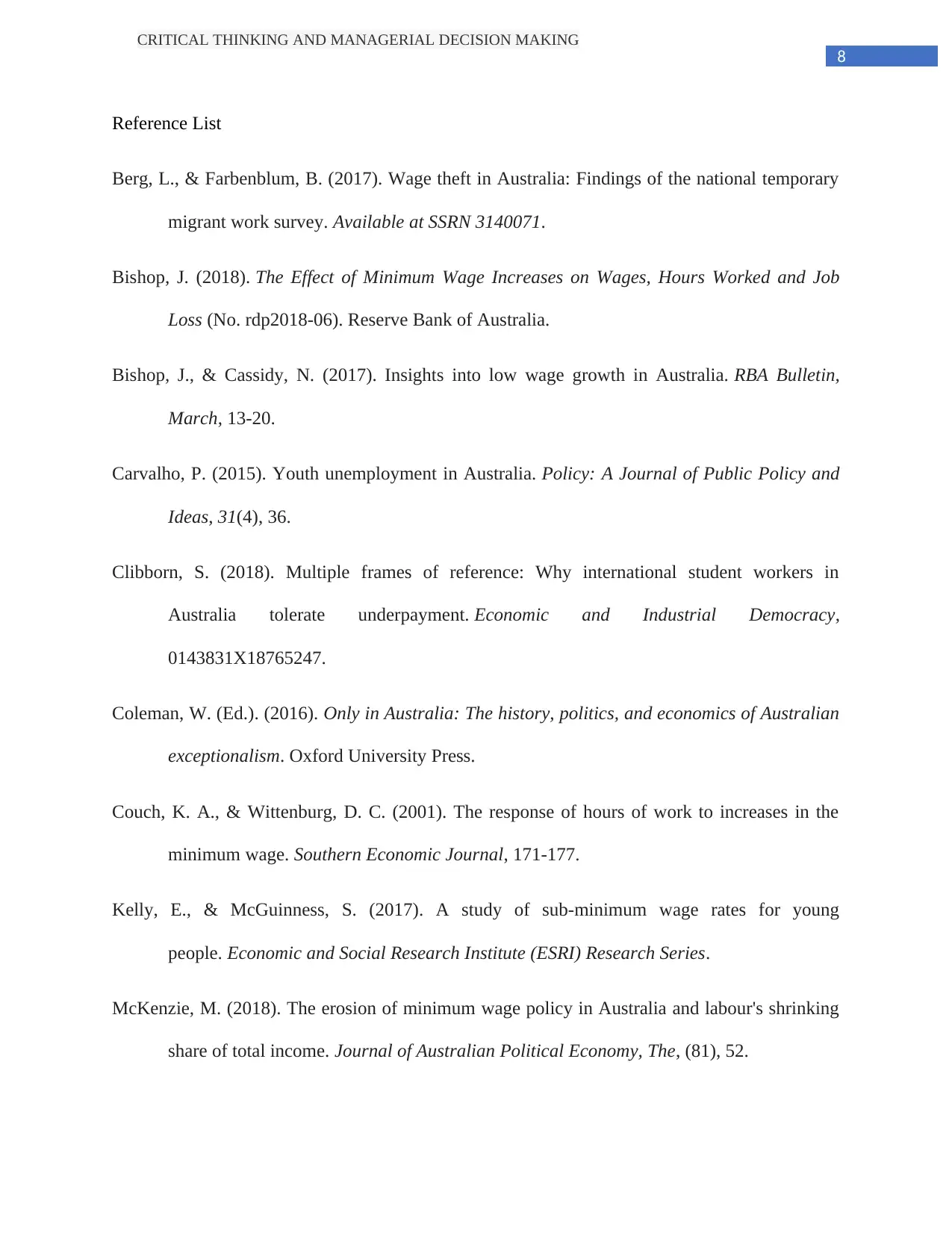
8
CRITICAL THINKING AND MANAGERIAL DECISION MAKING
Reference List
Berg, L., & Farbenblum, B. (2017). Wage theft in Australia: Findings of the national temporary
migrant work survey. Available at SSRN 3140071.
Bishop, J. (2018). The Effect of Minimum Wage Increases on Wages, Hours Worked and Job
Loss (No. rdp2018-06). Reserve Bank of Australia.
Bishop, J., & Cassidy, N. (2017). Insights into low wage growth in Australia. RBA Bulletin,
March, 13-20.
Carvalho, P. (2015). Youth unemployment in Australia. Policy: A Journal of Public Policy and
Ideas, 31(4), 36.
Clibborn, S. (2018). Multiple frames of reference: Why international student workers in
Australia tolerate underpayment. Economic and Industrial Democracy,
0143831X18765247.
Coleman, W. (Ed.). (2016). Only in Australia: The history, politics, and economics of Australian
exceptionalism. Oxford University Press.
Couch, K. A., & Wittenburg, D. C. (2001). The response of hours of work to increases in the
minimum wage. Southern Economic Journal, 171-177.
Kelly, E., & McGuinness, S. (2017). A study of sub-minimum wage rates for young
people. Economic and Social Research Institute (ESRI) Research Series.
McKenzie, M. (2018). The erosion of minimum wage policy in Australia and labour's shrinking
share of total income. Journal of Australian Political Economy, The, (81), 52.
CRITICAL THINKING AND MANAGERIAL DECISION MAKING
Reference List
Berg, L., & Farbenblum, B. (2017). Wage theft in Australia: Findings of the national temporary
migrant work survey. Available at SSRN 3140071.
Bishop, J. (2018). The Effect of Minimum Wage Increases on Wages, Hours Worked and Job
Loss (No. rdp2018-06). Reserve Bank of Australia.
Bishop, J., & Cassidy, N. (2017). Insights into low wage growth in Australia. RBA Bulletin,
March, 13-20.
Carvalho, P. (2015). Youth unemployment in Australia. Policy: A Journal of Public Policy and
Ideas, 31(4), 36.
Clibborn, S. (2018). Multiple frames of reference: Why international student workers in
Australia tolerate underpayment. Economic and Industrial Democracy,
0143831X18765247.
Coleman, W. (Ed.). (2016). Only in Australia: The history, politics, and economics of Australian
exceptionalism. Oxford University Press.
Couch, K. A., & Wittenburg, D. C. (2001). The response of hours of work to increases in the
minimum wage. Southern Economic Journal, 171-177.
Kelly, E., & McGuinness, S. (2017). A study of sub-minimum wage rates for young
people. Economic and Social Research Institute (ESRI) Research Series.
McKenzie, M. (2018). The erosion of minimum wage policy in Australia and labour's shrinking
share of total income. Journal of Australian Political Economy, The, (81), 52.

9
CRITICAL THINKING AND MANAGERIAL DECISION MAKING
Preston, A. (2018). The structure and determinants of wage relativities: evidence from Australia.
Routledge.
CRITICAL THINKING AND MANAGERIAL DECISION MAKING
Preston, A. (2018). The structure and determinants of wage relativities: evidence from Australia.
Routledge.
⊘ This is a preview!⊘
Do you want full access?
Subscribe today to unlock all pages.

Trusted by 1+ million students worldwide
1 out of 9
Related Documents
Your All-in-One AI-Powered Toolkit for Academic Success.
+13062052269
info@desklib.com
Available 24*7 on WhatsApp / Email
![[object Object]](/_next/static/media/star-bottom.7253800d.svg)
Unlock your academic potential
Copyright © 2020–2025 A2Z Services. All Rights Reserved. Developed and managed by ZUCOL.





